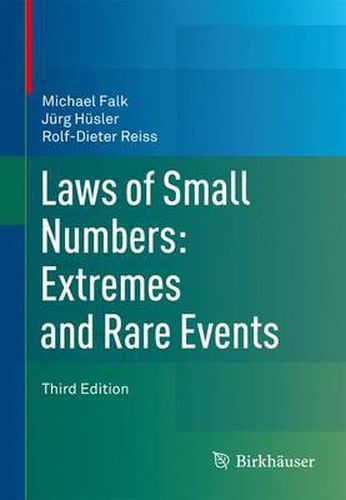Readings Newsletter
Become a Readings Member to make your shopping experience even easier.
Sign in or sign up for free!
You’re not far away from qualifying for FREE standard shipping within Australia
You’ve qualified for FREE standard shipping within Australia
The cart is loading…






This title is printed to order. This book may have been self-published. If so, we cannot guarantee the quality of the content. In the main most books will have gone through the editing process however some may not. We therefore suggest that you be aware of this before ordering this book. If in doubt check either the author or publisher’s details as we are unable to accept any returns unless they are faulty. Please contact us if you have any questions.
Since the publication of the first edition of this seminar book in 1994, the theory and applications of extremes and rare events have enjoyed an enormous and still increasing interest. The intention of the book is to give a mathematically oriented development of the theory of rare events underlying various applications. This characteristic of the book was strengthened in the second edition by incorporating various new results. In this third edition, the dramatic change of focus of extreme value theory has been taken into account: from concentrating on maxima of observations it has shifted to large observations, defined as exceedances over high thresholds. One emphasis of the present third edition lies on multivariate generalized Pareto distributions, their representations, properties such as their peaks-over-threshold stability, simulation, testing and estimation.
Reviews of the 2nd edition:
In brief, it is clear that this will surely be a valuable resource for anyone involved in, or seeking to master, the more mathematical features of this field.
David Stirzaker, Bulletin of the London Mathematical Society
Laws of Small Numbers can be highly recommended to everyone who is looking for a smooth introduction to Poisson approximations in EVT and other fields of probability theory and statistics. In particular, it offers an interesting view on multivariate EVT and on EVT for non-iid observations, which is not presented in a similar way in any other textbook.
Holger Drees, Metrika
$9.00 standard shipping within Australia
FREE standard shipping within Australia for orders over $100.00
Express & International shipping calculated at checkout
This title is printed to order. This book may have been self-published. If so, we cannot guarantee the quality of the content. In the main most books will have gone through the editing process however some may not. We therefore suggest that you be aware of this before ordering this book. If in doubt check either the author or publisher’s details as we are unable to accept any returns unless they are faulty. Please contact us if you have any questions.
Since the publication of the first edition of this seminar book in 1994, the theory and applications of extremes and rare events have enjoyed an enormous and still increasing interest. The intention of the book is to give a mathematically oriented development of the theory of rare events underlying various applications. This characteristic of the book was strengthened in the second edition by incorporating various new results. In this third edition, the dramatic change of focus of extreme value theory has been taken into account: from concentrating on maxima of observations it has shifted to large observations, defined as exceedances over high thresholds. One emphasis of the present third edition lies on multivariate generalized Pareto distributions, their representations, properties such as their peaks-over-threshold stability, simulation, testing and estimation.
Reviews of the 2nd edition:
In brief, it is clear that this will surely be a valuable resource for anyone involved in, or seeking to master, the more mathematical features of this field.
David Stirzaker, Bulletin of the London Mathematical Society
Laws of Small Numbers can be highly recommended to everyone who is looking for a smooth introduction to Poisson approximations in EVT and other fields of probability theory and statistics. In particular, it offers an interesting view on multivariate EVT and on EVT for non-iid observations, which is not presented in a similar way in any other textbook.
Holger Drees, Metrika